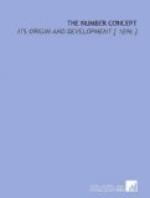CHAPTER IV.
THE ORIGIN OF NUMBER WORDS.
(CONTINUED.)
By the slow, and often painful, process incident to the extension and development of any mental conception in a mind wholly unused to abstractions, the savage gropes his way onward in his counting from 1, or more probably from 2, to the various higher numbers required to form his scale. The perception of unity offers no difficulty to his mind, though he is conscious at first of the object itself rather than of any idea of number associated with it. The concept of duality, also, is grasped with perfect readiness. This concept is, in its simplest form, presented to the mind as soon as the individual distinguishes himself from another person, though the idea is still essentially concrete. Perhaps the first glimmering of any real number thought in connection with 2 comes when the savage contrasts one single object with another—or, in other words, when he first recognizes the pair. At first the individuals composing the pair are simply “this one,” and “that one,” or “this and that”; and his number system now halts for a time at the stage when he can, rudely enough it may be, count 1, 2, many. There are certain cases where the forms of 1 and 2 are so similar than one may readily imagine that these numbers really were “this” and “that” in the savage’s original conception of them; and the same likeness also occurs in the words for 3 and 4, which may readily enough have been a second “this” and a second “that.” In the Lushu tongue the words for 1 and 2 are tizi and tazi respectively. In Koriak we find ngroka, 3, and ngraka, 4; in Kolyma, niyokh, 3, and niyakh, 4; and in Kamtschatkan, tsuk, 3, and tsaak, 4.[108] Sometimes, as in the case of the Australian races, the entire extent of the count is carried through by means of pairs. But the natural theory one would form is, that 2 is the halting place for a very long time; that up to this point the




